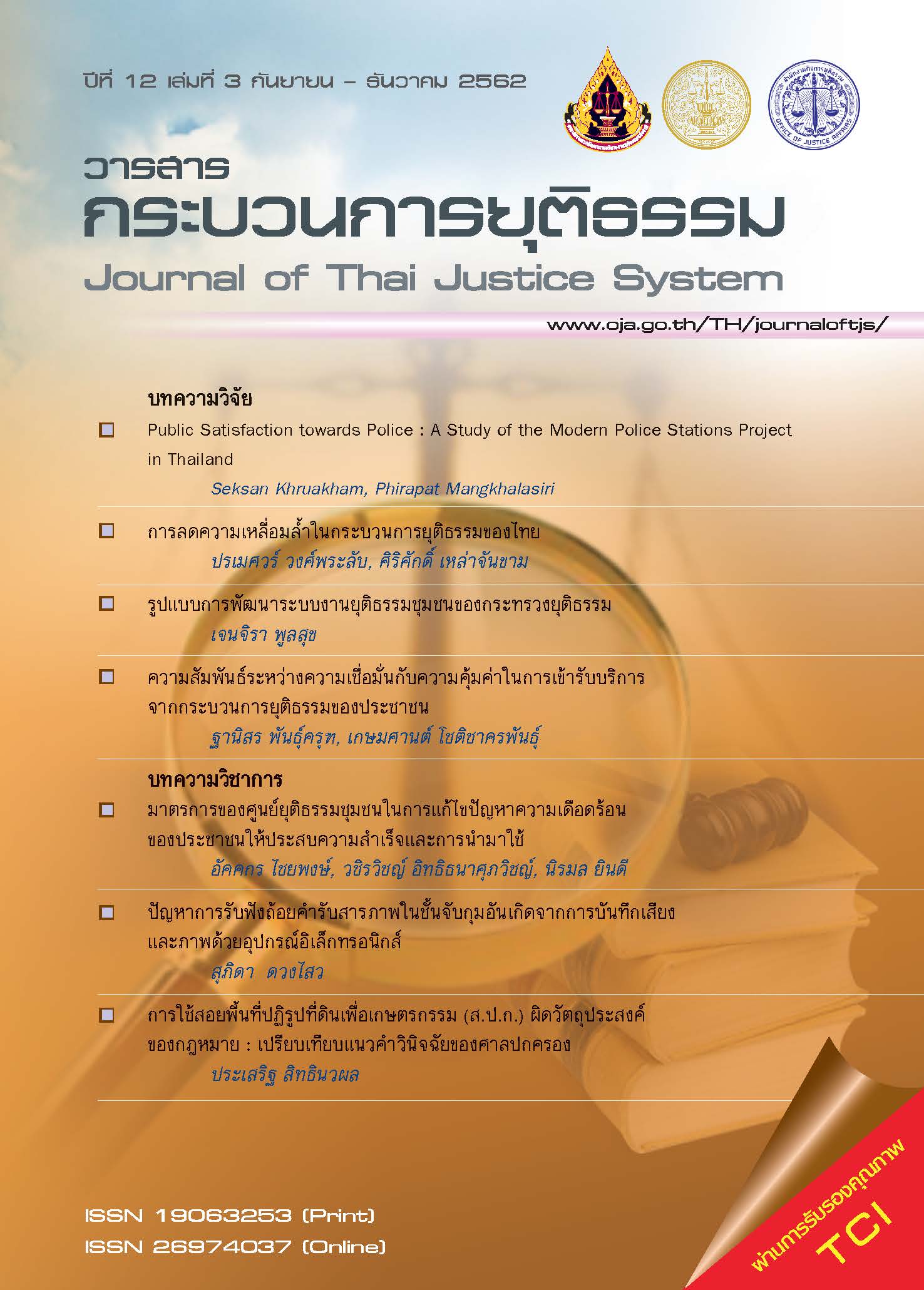The Measures of Community Justice Center for Solving the Problems of People to Become Successful and Naturalized
Main Article Content
Abstract
The study of the measures of community justice center for solving the problems of people to become successful and naturalized aims to analyze the measures of community justice center for reaching effective solution to the problems making people get into trouble as well as to put them into the most efficient and effective practices. It is certain that the success and achievement of community justice center needed to be contingent on the measures of establishment by the state, cultural, and traditional strength. In addition, the structures needed to be consistent with the concept of community justice, in conjunction with reconciliation justice and wisdom in administrative management. These elements played a pivotal role in rendering community justice center become successful as well as virtually helping to solve the problems faced by people. In order to enforce community justice with effectiveness, it is necessary to encourage people in the community to participate in empowering community justice as the tool by themselves without having their roles and operation intervened by the state agencies. This way can therefore be consistent with the concepts of justice community center, making it capable of solving the problems of people successfully, together with having to be reinforced by the laws that promote public participation, such as Community Justice Center Act.
Article Details
Published Manuscripts are the copyright of the Journal of the Justice System. However; the opinions that appeared in the content are the sole responsibility of the author.
References
กิตติพงษ์ กิตยารักษ์ และจุฑารัตน์ เอื้ออำนวย. (2558). ยุติธรรมชุมชน. ค้นจากhttp://law.stou.ac.th/dynfiles/Ex.41716-15.pdf
คณะรัฐศาสตร์ จุฬาลงกรณ์มหาวิทยาลัยและสำนักพัฒนาและส่งเสริมการบริหารงานยุติธรรมจังหวัดและยุติธรรมทางเลือก. (2555). สรุปผลการสัมมนาเชิงปฏิบัติการและศึกษาดูงานทั้งในและต่างประเทศตามโครงการสนับสนุนการขับเคลื่อนนโยบายกระทรวงยุติธรรมส่วนภูมิภาค. กรุงเทพฯ: คณะรัฐศาสตร์ จุฬาลงกรณ์มหาวิทยาลัยและสำนักพัฒนาและส่งเสริมการบริหารงานยุติธรรมจังหวัดและยุติธรรมทางเลือก.
จุฑารัตน์ เอื้ออำนวย. (2556). ระบบยุติธรรมและยุติธรรมทางเลือก : แนวการวิเคราะห์เชิงสังคมศาสตร์. กรุงเทพฯ: สำนักพิมพ์แห่งจุฬาลงกรณ์มหาวิทยาลัย.
จุฑารัตน์ เอื้ออำนวย, สุทธิ สุขยิ่ง และมูฮัมหมัดรอฟีอี มูซอ. (2549). ยุติธรรมชุมชน : การเปิดพื้นที่ของชุมชนในการอำนวยความยุติธรรม. กรุงเทพฯ: สำนักงานกองทุนสนับสนุนการวิจัย.
ชญานันท์ ล้อมณีนพรัตน์. (2553). ยุติธรรมชุมชน: ศึกษากรณีการแก้ไขความขัดแย้งทางอาญาด้วยวิธีการเชิงสมานฉันท์ในระดับชุมชน. (วิทยานิพนธ์นิติศาสตร์มหาบัณฑิต) สาขาวิชานิติศาสตร์, คณะนิติศาสตร์ จุฬาลงกรณ์มหาวิทยาลัย.
วนิตยา โพธิ์นอก และณัฏฐกาญจน์ ศุกลรัตนเมธี. (2560). ระบบยุติธรรมชุมชนในประเทศประชาคมอาเซียน : กรณีศึกษาสาธารณรัฐประชาธิปไตยประชาชนลาว. กรุงเทพฯ: สถาบันพระปกเกล้า.
ศรวิชา กฤตาธิการและไชยยศ ไพวิทยศิริธรรม. (2560). ข้อเสนอเชิงนโยบายยุติธรรมชุมชนเพื่อเสริมสร้างความสมานฉันท์ของชุมชนอย่างยั่งยืน. วารสารศิลปากรศึกษาศาสตร์วิจัย, 9(2), 122-133.
ส่วนนโยบายและยุทธศาสตร์ยุติธรรมชุมชนและยุติธรรมจังหวัด. (2560). ศูนย์ยุติธรรมชุนชนที่มีศักยภาพเกรด A ถึง เกรด D. กรุงเทพฯ: สำนักงานกิจการยุติธรรม กระทรวงยุติธรรม.
ส่วนนโยบายและยุทธศาสตร์ยุติธรรมชุมชนและยุติธรรมจังหวัด สำนักงานกิจการยุติธรรม กระทรวงยุติธรรม. (2562). ข้อมูลการจัดตั้งสำนักงานยุติธรรมจังหวัดและยุติธรรมชุมชน. กรุงเทพฯ:ส่วนนโยบายและยุทธศาสตร์ยุติธรรมชุมชนและยุติธรรมจังหวัด สำนักงานกิจการยุติธรรม กระทรวงยุติธรรม.
อัคคกร ไชยพงษ์, วชิรวิชญ์ อิทธิธนาศุภวิชญ์และศุภัทรชญา วีระกูล. (2561). การประยุกต์ใช้วิถีวัฒนธรรมชุมชนของอำเภอสามโคก จังหวัดปทุมธานี ในการควบคุมอาชญากรรม. วารสารสมาคมนักวิจัย, 23(2), 115-126.
Bazemore, G. and Schiff, M. (2001). Restorative Community Justice: Repairing Harm and Transforming Community. Cincinnati: Anderson Publishing.
David R.Karp and Todd R.Clear. (2000). COMMUNITY JUSTICE: A CONCRPTUAL FRAMEWORK”. Boundary Chanhes in Criminal Justice (Criminal Justice), 2, 331.
Kuri, Leena. (2000). “Restorative and Community Justice in the United States.” In Crime and Justice : A Review of Research 27, 235-303. Edited by Michael Tonry. Chicago: University of Chicago Press, 2000, 235.

